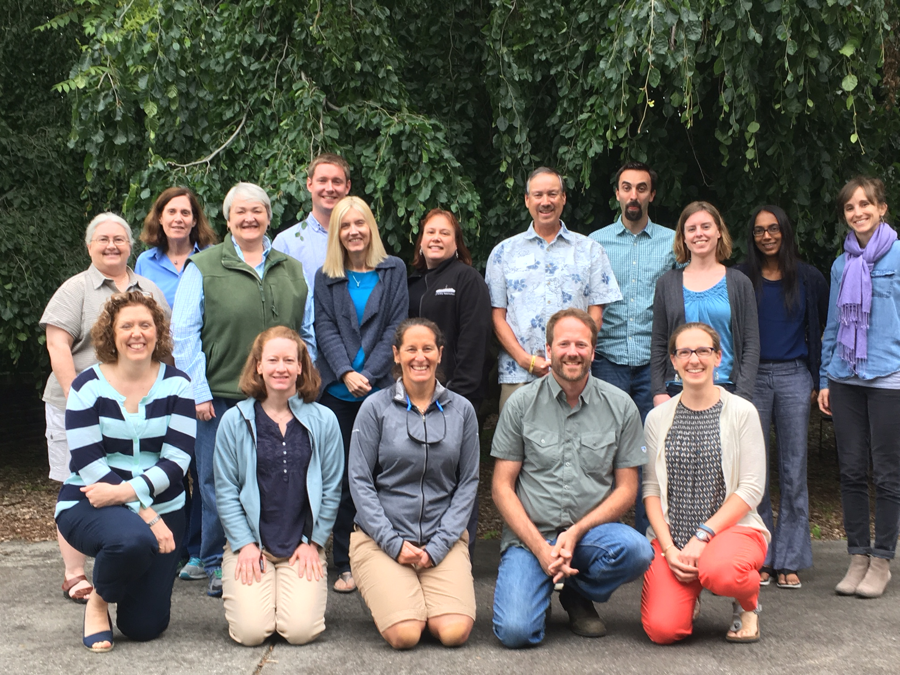Exploring Geology in the Ocean with OOI Data
OOI Teaching with Data Workshop (June 2-4, 2017)

During a Spring 2017 workshop (June 2-4), ten undergraduate professors convened at Rutgers University to focus on the integration of data into undergraduate teaching of introductory oceanography themes and concepts using data from the Ocean Observing Initiative (OOI). Professors who were interested in using online data and who do exemplary work in undergraduate teaching were invited to attend. Workshop participants explored ways to effectively teach with data, shared their personal effective practices, expanded their understanding of effective pedagogy, and brainstormed ideas for how to integrate OOI data into Introduction to Oceanography courses.
For this workshop we chose to focus on features of Plate Tectonics & the Ocean Floor, as the overarching topic area. During the workshop, participants were asked to provide detailed feedback on the activities, including their perceived utility and effectiveness of the activities in the classroom. It is the hope, that each participant will utilize the activities in their class and implement a short student assessment to help us collect some initial information on the students' impression of the OOI activities.
Data Scope
Our scope in exploring ways to use professionally-collected data in our teaching:
- Using professionally-collected data in teaching of concepts
- Visualizing data in a user-friendly and authentic way
- Enabling students to interactively engage with data in their learning to see the patterns as they are learning the why
Presentations
- Welcome from the OOI Program (Mike Crowley)
- Introduction to the Learning Cycle (Catherine Halversen)
- Axial Seamount Overview Discussion (Deb Kelley)
- Foundational Ideas of Learning (Catherine Halversen)
- Hydrothermal Vents (Friedrich Knuth)
Workshop Resources
Handouts
Axial Seamount Resources
- NOAA Axial Blog - Follow the NOAA scientists efforts to forecast the 2015 eruption from 2012 onward, through descriptions of what really happened and how they approached this same problem.
- Earth-Oceans Interaction Program Axial 2015 Video Blog
- #2 Monitoring - Learn more about why and how scientists are monitoring the active volcano of the Axial Seamount
- #9 Pressure Measurements - Learn more about how the pressure measurements are taken to understand movement of magma under the seafloor and changes in the seafloor elevation
- #10 Facilitating Science - Learn more about who works on the research vessel to make this science happen
- Wilcock et al. (2016). Seismic constraints on caldera dynamics from the 2015 Axial Seamount eruption, Science 354(6318).
- NOAA PMEL - Earth-Oceans Interaction Program's Realtime data from the OOI BPR/Tilt instruments at Axial
Shared Activities
- Silke Severmann's Hurricanes & Superstorms Worksheet, Answer Key, and Online Activity
- Anna's homework and screenshots
- Shared Geology related lessons with data
- Coming Soon
OOI Resources
OOI Education Tools
OOI Information
- OOI Major Science Themes
- OOI History & Context - Learn more about why the OOI came to be what it is and where it is going in the future
- OOI Data Portal - Access other OOI collected data to explore with your students (check out the video tutorials)
- NASA Panoply for quick viewing netcdf files
- Research Arrays List (alternative)
- Instruments List (alternative)
- Data Products List
- Glossary
Additional Resources
Suggested Links from Participants
- EarthWind Map - Multi-layered, interactive, near-real-time model of Earth's oceanic and atmospheric features
Teaching with Data Resources
- SERC Teaching with Data Definition - NSF workshop participants at "Using Data in the Undergraduate Science Classroom" (UD) created a useful operational definition to guide our understanding of the meaning of "Teaching With Data."
Project Team
| Name | Institution | Project Role |
|---|---|---|
| Janice McDonnell | Rutgers University | Project Manager, Workshop Facilitator |
| Kristin Hunter-Thomson | Rutgers University | Data Activity Development |
| Sage Lichtenwalner | Rutgers University | Data Processing, Visualization Tool & Website Development |
| Catherine Halversen | Lawrence Hall of Science, University of California, Berkeley | Pedagogy and Effective Teaching Instructor |
Project Participants
- Al Trujillo (Palomar College)
- Anna Pfeiffer-Herbert (Stockton University)
- Cheryl Greengrove (University of Washington, Tacoma)
- Deb Kelley (University of Washington)
- Denise Bristol (Hillsborough Community College, South Shore Campus)
- Ellen Cowan (Appalachian State University)
- Julie Bowles (University of Wisconsin)
- Kusali Gamage Sooriarachchi (Austin Community College)
- Marina Halverson (Seattle Central College)
- Rachel Teasdale (California State University, Chico)
- Rus Higley (Highline College)